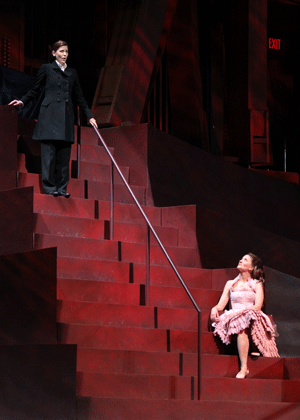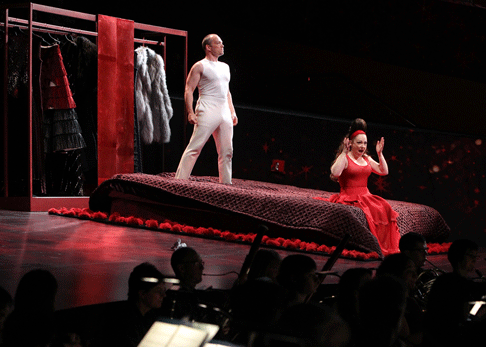It all began with an original French play, titled La Folle JournÈe, ou
le Mariage de Figaro (A† Crazy Day, or The Marriage of Figaro), written
by Pierre-Augustin Caron de Beaumarchais in 1773. The work,which was not
produced until 1778, had strong political and social overtones, which helped
disseminate the concepts of equality and individual rights, that led to the
French revolution. Note, however, that at during the period that Beaumarchais
was writing his plays, he was also employed by both Louis XV and XVI for secret
missions in London.† There are numerous sources for information about
Beaumarchais’ amorous adventures.† For his life as a secret agent, see the
CIA’s (unclassified) web page titled “Beaumarchais and the American
Revolution.Ӡ
Lorenzo Da Ponte, the poet, who wrote the Italian libretto, was also a man
given to wanderings and strange connections.† An ex-Jew, and ex-priest, who
had been banished from Venice for licentious behavior, not only did he know
Mozart, Casanova and Clement C, Moore (of The Night Before Christmas
fame), but Samuel F. B Morse, inventor of the telegraph painted the poet’s
portrait, which once hung in Columbia University.† Da Ponte’s autobiography
which describes some of his lurid adventures, is not completely to be
trusted.
 Rachel Frenkel as Cherubino and Malin Christensson as Susanna
Rachel Frenkel as Cherubino and Malin Christensson as Susanna
It was Wolfgang Amadeus Mozart, who proposed using the Beaumarchais play as
an opera libretto to Da Ponte, with the stipulation that the harsh political
overtones be removed.† Professor Robert Greenberg considers The Marriage
of Figaro, which is Mozart’s most popular opera, “among the greatest
achievements of artistic striving.” Following their collaboration for The
Marriage of Figaro, Mozart and Da Ponte produced two more works, Don
Giovanni and CosÏ fan tutte.
While it is not unusual for an opera company to plan Mozart/Da Ponte
festivals, it is† extraordinary for an orchestra housed in a concert hall to
undertake the task.† Even more extraordinary are the lengths and expense to
which the Los Angeles Orchestra has gone to produce these performances.† The
installation and sets for Don Giovanni, which they offered last year, were
created by architect Frank Gehry, who had designed the Disney Concert Hall.†
Fashion designers Kate and Laura Mulleavy of Rodarte, created the costumes.†
This year, presumably in honor of† Beaumarchais and the opera’s Gallic
origins, Jean Nouvel, a French architect created the performance area and
Parisian based designer Azzedine AlaÔa designed the costumes. †Both operas
were directed by Christopher Alden.†
Don Giovanni was set on a narrow strip of stage in an all white,
galactic looking universe. The† orchestra was behind the stage, so that
singers had to follow the conductors beat on monitors.† Nouvel created a
deeper stage in a rich maroon color† At the rear, a staircase rose toward the
organ.† The stage surface wound around a newly created orchestra† pit to form
an apron that allowed for interaction between performers and instrumentalists –
and even with the conductor.†† This, in fact, provided some moments of fun,
which sadly, was often lacking on stage.†
This was a musically superb Marriage of Figaro.† In direct eye
contact with the singers as well as the orchestra, Maestro Dudamel conducted a
brilliant performance with the fluidity and precision that Mozart demands.†
While he hadn’t used a score for Don Giovanni, he did employ one for the
Marriage of Figaro, at least for the performance I attended on May 19th.††
The large, well chosen cast made for additional musical pleasure.† Baritone
Edwin Crossley-Mercer was an unusually lustrous voiced, though angry Figaro.†
Swedish soprano, Malin Christensson’s shimmering Susanna was pert and
charming.† As the Countess, soprano Dorothea Rˆschmann, known world-wide for
the role, made her two great arias testaments to her character’s deep sorrow.†
Christopher Maltman was a suave, elegant, and seductive Count, and Rachel
Frenkel offered a charmingly confused Cherubino.† John Del Carlo and Ann
Murray, as Bartolo and Marcellina were luxury casting as a pair of unsuccessful
plotters, turned loving parents.† William Ferguson, who sang Basilio, and
Simone Osborne, as Barbarina, as well as John Irvin and Brandon Cedel, were all
excellent.† The Los Angeles Master Chorale was a pleasant but almost invisible
presence curtained off high and far behind the stage.
 Christopher Maltman as the Count and Dorothea Rˆschmann as the Countess
Christopher Maltman as the Count and Dorothea Rˆschmann as the Countess
While Mozart was well served by the orchestra and singers, our two witty,
humanist librettists were not.† When, as the fizzy overture was still being
played, the cast wandered onto the stage at a languid, funereal pace. I should
have known that this was not to be an entertaining, much less funny theater
piece.† The stage though large, was essentially an empty space with no exits
or entrances, no place to hide.† Artfully arranged lighting created shaded
places, generally on the floor, to which singers retreated in various positions
until called upon to sing once again.† In the last act, there were three such
bodies on the floor, making the scene appear more like the end of Shakespearean
tragedy than an† operatic farce.† One could read titles, and hear voices, but
often could not locate the singers.† Figaro sang his teasing, “non piu
andrai” to the audience, standing on the apron to left of the conductor.†
Meanwhile, Cherubino to whom the words are addressed stood at rigid attention
far behind him and the orchestra.† The famous comedic chair scene was
performed without a chair or comedy.† I have no idea what the costumer had in
mind.† At one point Susanna in a short skirt with cascading blond hair, looked
like Alice straight out of Wonderland.† And when she wore her elegant white
wedding dress, Figaro, beside her, wore a tight fitting zipped to the neck
sweater, looking for all the world like a president about to deliver a fire
side chat.† As in last year’sDon Giovanni, the English titles told
the audience†† things they didn’t see.† It was impossible even for
knowledgeable opera goers to follow the action, particularly in the garden
scene.†
For all its visual failings, however, this staging of The Marriage
of Figaro, was more successful than the Don Giovanni.† The
use of the large stage improved sight lines.† Placing the orchestra in a pit
allowed for freer music making.†† Perhaps next year’s CosÏ fan
tutte, will be ther lucky third that gets it all right.
Estelle Gilson
Production and cast information:
Figaro: Edwin Crossley-Mercer; Susanna: Malin Christensson;
Bartolo: John Del Carlo; Marcellina: Ann Murray; Cherubino: Rachel Frenkel; Don
Basilio: William Freguson; Count Almaviva: Christopher Maltman; Countess
Almaviva: Dorothea Rˆschmann; Antonio: Brandon Cedel; Don Curzio: John Irvin;
Barbarina: Simone Osborne. Los Angeles Philharmonic. Gustavo Dudamel, conductor.
Christopher Alden, director. Jean Nouvel, installations. Azzedine AlaÔa,
costume design. Aaron Black, lighting design.
image=http://www.operatoday.com/PY7C2474.gif
image_description=Malin Christensson as Susanna and Edwin Crossley-Mercer as Figaro [Photo by Craig T. Mathew & Greg Grudt/Mathew Imaging]
product=yes
product_title=“Marriage” at the Los Angeles Philharmonic
product_by=A review by Estelle Gilson
product_id=Above: Malin Christensson as Susanna and Edwin Crossley-Mercer as Figaro
Photos by Craig T. Mathew & Greg Grudt/Mathew Imaging